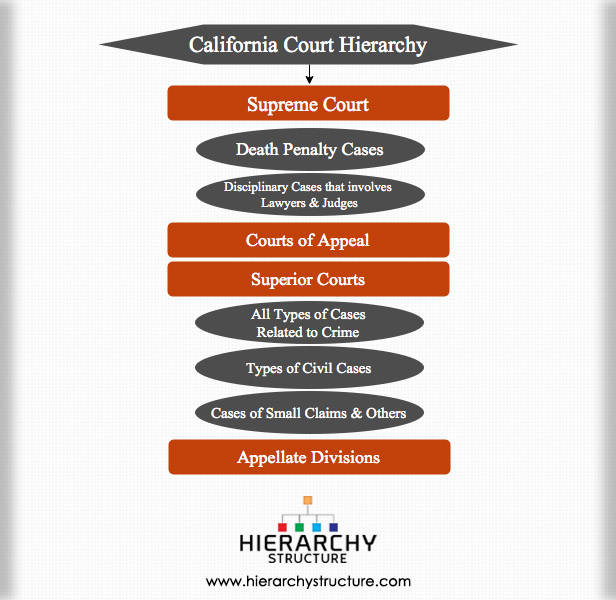The Judiciary of California, as defined in the Constitution of California, has a hierarchical structure with the Supreme Court at the apex, courts of appeal as the appellate courts of the first order, and the superior courts as the trial courts of the first order. It’s administration is looked after by the Judicial Council and its staff, and the autonomous courts, whereby judges are first appointed by the Governor at the superior courts and at higher levels, and are subjected to the retention elections. The California Court hierarchy is as described below:
Supreme Court
The Supreme Court acts as the highest order in California. It reviews cases, which have been decided by Courts of Appeal and these then are directed to Supreme Court instead of being heard in courts of Appeal. Such cases are the
- Death penalty cases
- Disciplinary cases that involves lawyers and judges
The Supreme Court has its headquarters in San Francisco, and branch offices in Sacramento and Los Angeles. Regular court proceedings are held in all three cities and sometimes special sessions are held in the other cities of California as well. The Supreme Court of California consists of the six Associate Justices and the Chief Justice of California. The appointment of the lawyers is done by the Governor and is followed by the confirmation by voters in the subsequent general election. Then after the completion of a term of 12 years, voters should do confirmation of their position. It is important that justices must have been lawyers who have cleared the California Bar Examination or they could have also worked in the position a judge for a period of 10 years in a court of California, before they are appointed.
Courts of appeal
The California courts of appeal acts as the intermediate appellate courts and there are six appellate districts in it. This court tries cases like:
- People who are dissatisfied with the decision of a trial court can appeal to an Appellate Court and thereby asks the higher-level court to change the verdict of the trial courts. The role of these courts is to review the records of the superior Courts to check for any legal errors.
The District headquarters for the Courts of Appeal are located in San Francisco (First Appellate District), Los Angeles (Second District), Sacramento (Third District), San Diego (Fourth District), Fresno (Fifth District) and San Jose (Sixth District). The three judges known as justices in these courts decide on the appeals made from the trial courts.
Superior courts
The California superior courts hear both civil and criminal cases and never put on trial in other courts. It handles cases like:
- All types of cases related to crime
- Types of civil cases
- Cases of small claims and others
There is 58 Superior Courts.
Appellate divisions
Superior courts have appellate divisions, which means superior court judges acting as appellate judges and hears appeals from decisions of other commissioners or superior court judges. They hear and decide relatively minor cases, which have been heard in the inferior courts earlier.
The Californian judicial system is by far the biggest in United States and is fully staffed by professional law-trained judges
Know about California State Police Hierarchy.

